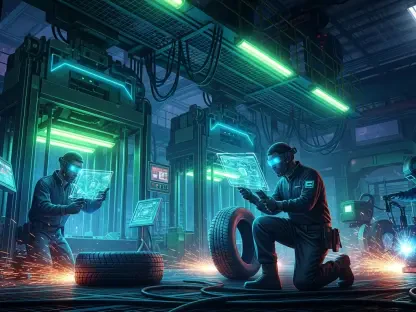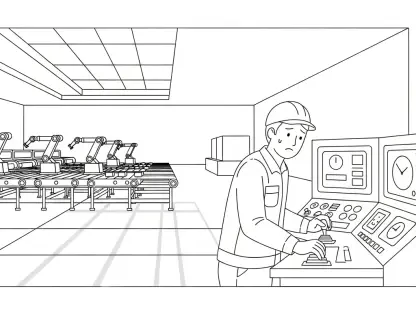In a world where manufacturing downtime can bleed companies dry at a staggering rate of $10,000 to $250,000 per hour, a surprising hero has emerged from the most unlikely of places: the smartphone. Unveiled at a major industry event this year, a groundbreaking $499 app by Olis Robotics is turning standard Android devices into powerful diagnostic tools for industrial automation, raising a compelling question about whether the everyday gadget in your pocket can truly transform the gritty, high-stakes landscape of heavy industry.
The Pocket-Sized Powerhouse: Smartphones as Industrial Game-Changers
At the heart of this technological shift lies a simple yet profound ideleveraging devices most people already own to tackle complex industrial challenges. The Olis Robotics app, compatible with Android smartphones and tablets, connects to factory automation controllers via Ethernet, delivering real-time insights that once required costly industrial PCs. This accessibility could democratize advanced diagnostics, making sophisticated tools available to even small-scale manufacturers.
What sets this apart is not just the price point but the immediacy it offers. Engineers no longer need to wait for specialized equipment or travel long distances to troubleshoot a malfunctioning robot. Instead, a device already in hand becomes a window into the factory floor, promising to slash millions in downtime costs and reshape how industries approach operational efficiency.
The Urgent Need for a Digital Shift in Industry
Industrial automation is at a critical juncture, grappling with inefficiencies that can cripple profitability. With unplanned stoppages costing manufacturers dearly, the pressure to minimize disruptions has never been higher. Beyond financial losses, the logistics of on-site service calls add layers of delay and expense, often requiring technicians to cross state lines or even countries to address a single issue.
Safety remains another pressing concern in this high-speed environment. Observing automation processes up close poses significant risks, yet halting production for diagnostics is often not an option. A digital overhaul, integrating remote and accessible technologies, emerges as a vital solution to keep pace with global competition and meet the escalating demands for both safety and efficiency.
Inside the Olis Robotics App: Features That Transform Operations
Diving into the specifics, the Olis Robotics app offers a suite of capabilities designed to address industry pain points head-on. Through instant remote monitoring, it provides access to robot telemetry, system logs, and synchronized live video feeds within minutes of setup. This means pinpointing a glitch—whether a mistimed gripper or a failing valve—without ever stepping onto the factory floor.
Cost savings are a standout benefit, as the app eliminates the need for expensive travel. Josh Mayse, VP and co-founder of Mid Atlantic Machinery, emphasizes its value, stating, “Time is money, and saving just one flight makes this tool pay for itself.” Additionally, features like configurable alerts enable predictive maintenance, allowing companies to address potential breakdowns before they escalate into full-blown crises, further enhancing operational stability.
Safety also gets a significant boost with this technology. High-speed automation, often too dangerous to monitor in person, can now be observed through live feeds, reducing risks for engineers. Early adopters like Mid Atlantic Machinery are already integrating this app into new press-brake cell deployments, showcasing its practical impact across diverse industrial applications.
Real-World Impact: Stories and Voices from the Front Lines
Feedback from the field paints a vivid picture of this app’s transformative potential. At a recent industry expo in Chicago, engineers used the Olis app to resolve a collision issue for a Maryland-based client remotely, demonstrating its ability to bridge vast distances with ease. Such real-world examples highlight how this tool is not just a concept but a working solution already delivering results.
Industry leaders are quick to endorse its simplicity and effectiveness. Josh Mayse of Mid Atlantic Machinery notes, “This app cuts through complexity—it’s fast and intuitive.” Beta testing further confirms its user-friendliness, with setup times clocking in under five minutes, making it a viable option even for smaller operations with limited technical resources.
These testimonials underscore a broader shift toward digital solutions in industrial settings. For companies struggling with tight budgets and tighter timelines, the ability to troubleshoot remotely and efficiently is proving to be a game-changer, building confidence in smartphone-based tools as a legitimate industrial asset.
Practical Steps to Integrate Smartphone Tech into Industry
For businesses ready to embrace this innovation, adopting the Olis Robotics app is a straightforward process that requires minimal investment. At just $499, it can be installed on any standard Android device, bypassing the need for specialized hardware. This affordability opens doors for manufacturers of all sizes to access cutting-edge diagnostics.
Setup is equally hassle-free, taking less than five minutes to connect the device to an automation cell’s controller via Ethernet. Once configured, users can monitor operations through live video and telemetry, set alerts for anomalies, and use screen-sharing to guide on-site teams through troubleshooting, fostering seamless collaboration across distances.
Beyond immediate problem-solving, the app serves as a powerful training tool. It enables engineers to walk operators through processes in real time, building in-house expertise and reducing reliance on external support. This dual functionality—diagnostics and education—positions the app as a cornerstone for long-term operational improvement, paving the way toward predictive maintenance and enhanced safety protocols.
Reflecting on a Digital Leap Forward
Looking back, the journey of integrating smartphone technology into industrial automation marked a turning point for the sector. The Olis Robotics app stood as a beacon of innovation, proving that everyday devices could tackle monumental challenges like downtime and safety risks with remarkable efficiency. Its adoption by forward-thinking companies highlighted a collective readiness to embrace digital tools.
As industries moved forward from that pivotal moment, the focus shifted to scaling these solutions. Businesses were encouraged to explore how such accessible technologies could be customized to their unique needs, potentially integrating with other emerging systems for even greater impact. The path ahead invited collaboration between tech developers and manufacturers to refine and expand these tools, ensuring that the momentum of this digital revolution continued to build toward a more resilient industrial future.









